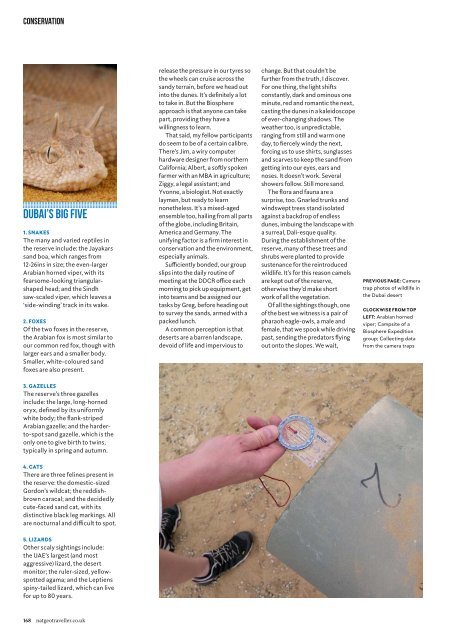National_Geographic_Traveller_UK_June_2017
You also want an ePaper? Increase the reach of your titles
YUMPU automatically turns print PDFs into web optimized ePapers that Google loves.
CONSERVATION<br />
DUBAI’S BIG FIVE<br />
1. SNAKES<br />
The many and varied reptiles in<br />
the reserve include: the Jayakars<br />
sand boa, which ranges from<br />
12-26ins in size; the even-larger<br />
Arabian horned viper, with its<br />
fearsome-looking triangularshaped<br />
head; and the Sindh<br />
saw-scaled viper, which leaves a<br />
‘side-winding’ track in its wake.<br />
2. FOXES<br />
Of the two foxes in the reserve,<br />
the Arabian fox is most similar to<br />
our common red fox, though with<br />
larger ears and a smaller body.<br />
Smaller, white-coloured sand<br />
foxes are also present.<br />
release the pressure in our tyres so<br />
the wheels can cruise across the<br />
sandy terrain, before we head out<br />
into the dunes. It’s definitely a lot<br />
to take in. But the Biosphere<br />
approach is that anyone can take<br />
part, providing they have a<br />
willingness to learn.<br />
That said, my fellow participants<br />
do seem to be of a certain calibre.<br />
There’s Jim, a wiry computer<br />
hardware designer from northern<br />
California; Albert, a softly spoken<br />
farmer with an MBA in agriculture;<br />
Ziggy, a legal assistant; and<br />
Yvonne, a biologist. Not exactly<br />
laymen, but ready to learn<br />
nonetheless. It’s a mixed-aged<br />
ensemble too, hailing from all parts<br />
of the globe, including Britain,<br />
America and Germany. The<br />
unifying factor is a firm interest in<br />
conservation and the environment,<br />
especially animals.<br />
Sufficiently bonded, our group<br />
slips into the daily routine of<br />
meeting at the DDCR office each<br />
morning to pick up equipment, get<br />
into teams and be assigned our<br />
tasks by Greg, before heading out<br />
to survey the sands, armed with a<br />
packed lunch.<br />
A common perception is that<br />
deserts are a barren landscape,<br />
devoid of life and impervious to<br />
change. But that couldn’t be<br />
further from the truth, I discover.<br />
For one thing, the light shifts<br />
constantly, dark and ominous one<br />
minute, red and romantic the next,<br />
casting the dunes in a kaleidoscope<br />
of ever-changing shadows. The<br />
weather too, is unpredictable,<br />
ranging from still and warm one<br />
day, to fiercely windy the next,<br />
forcing us to use shirts, sunglasses<br />
and scarves to keep the sand from<br />
getting into our eyes, ears and<br />
noses. It doesn’t work. Several<br />
showers follow. Still more sand.<br />
The flora and fauna are a<br />
surprise, too. Gnarled trunks and<br />
windswept trees stand isolated<br />
against a backdrop of endless<br />
dunes, imbuing the landscape with<br />
a surreal, Dali-esque quality.<br />
During the establishment of the<br />
reserve, many of these trees and<br />
shrubs were planted to provide<br />
sustenance for the reintroduced<br />
wildlife. It’s for this reason camels<br />
are kept out of the reserve,<br />
otherwise they’d make short<br />
work of all the vegetation.<br />
Of all the sightings though, one<br />
of the best we witness is a pair of<br />
pharaoh eagle-owls, a male and<br />
female, that we spook while driving<br />
past, sending the predators flying<br />
out onto the slopes. We wait,<br />
PREVIOUS PAGE: Camera<br />
trap photos of wildlife in<br />
the Dubai desert<br />
CLOCKWISE FROM TOP<br />
LEFT: Arabian horned<br />
viper; Campsite of a<br />
Biosphere Expedition<br />
group; Collecting data<br />
from the camera traps<br />
3. GAZELLES<br />
The reserve’s three gazelles<br />
include: the large, long-horned<br />
oryx, defined by its uniformly<br />
white body; the flank-striped<br />
Arabian gazelle; and the harderto-spot<br />
sand gazelle, which is the<br />
only one to give birth to twins,<br />
typically in spring and autumn.<br />
4. CATS<br />
There are three felines present in<br />
the reserve: the domestic-sized<br />
Gordon’s wildcat; the reddishbrown<br />
caracal; and the decidedly<br />
cute-faced sand cat, with its<br />
distinctive black leg markings. All<br />
are nocturnal and difficult to spot.<br />
5. LIZARDS<br />
Other scaly sightings include:<br />
the UAE’s largest (and most<br />
aggressive) lizard, the desert<br />
monitor; the ruler-sized, yellowspotted<br />
agama; and the Leptiens<br />
spiny-tailed lizard, which can live<br />
for up to 80 years.<br />
168 natgeotraveller.co.uk


















